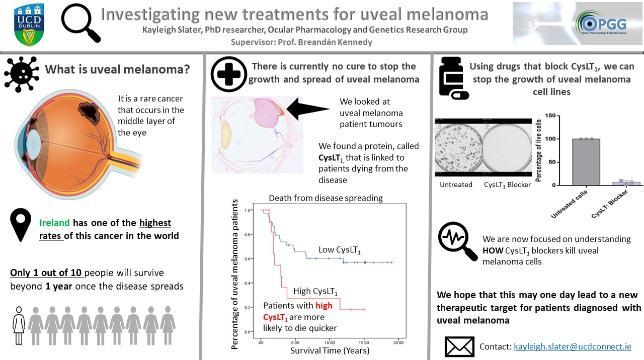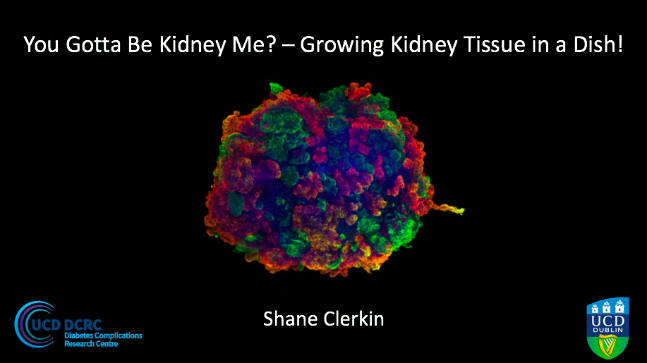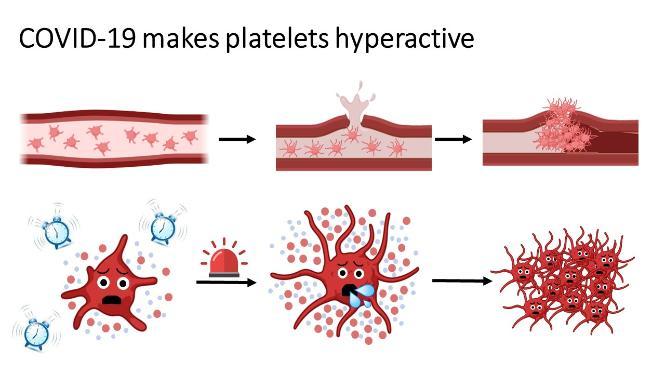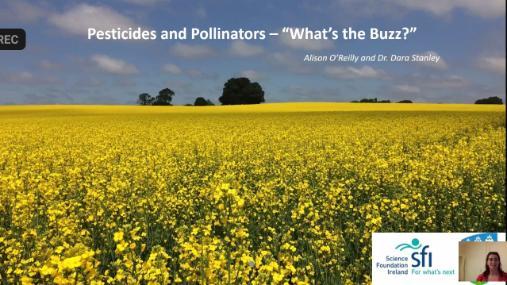ENGAGE 2021 Grand Final
News and Events
- 2024
- 2023
- 2022
- 2021
- UCD-led consortium secures EU funding to investigate disrupted signalling across a range of diseases
- Inaugural Shane Kenny Memorial Biotechnology Lecture
- Prof Geraldine Butler elected as Fellow to American Academy of Microbiology
- ENGAGE 2021 Grand Final
- Launch of National SARS-CoV-2 (COVID-19) Wastewater Surveillance Programme in Ireland
- Conway Sphere Research News
- Summer researchers contributing to Vaccine and Infection research
- Class of 2021 Conferring
- Prof Teresa Lambe UCD Alumni Award in Science 2021
- (opens in a new window)National SARS-CoV-2 (COVID-19) Wastewater Surveillance Programme in Ireland
- Prof Teresa Lambe UCD Alumni Award in Science
- SARS-CoV-2 water surveillance project
- 2020
- 2019
- 2018
- 2017
- 2016
- Vacancies
ENGAGE 2021 GRAND FINAL 14th April 2021
The winner of the ENGAGE 2021 Grand Final was Lisa McDonnell for her presentation entitled The Electrician who gets on your Nerves: Developing a new therapy for Multiple Sclerosis.

The ENGAGE Seminars are an annual science communication competition, hosted by the School of Biomolecular and Biomedical Science in University College Dublin, in which late-stage PhD students present their own PhD research to a public, non-specialist audience.
The ENGAGE 2021 Grand Final was held at 7pm on Wednesday 14th April 2021 through a live zoom webinar hosted by Dr. Craig Slattery, academic Coordinator for the UCD School of Biomolecular & Biomedical Science Public Science Communication module. There were six PhD student finalists and the overall winner was selected by a panel of guest judges from the arts, culture and charity sectors. The final event was open to anyone to attend.
The Runner Up prize went to Shane Clerkin for his presentation “You gotta be kidney me?” – growing kidney tissue in a dish!
Kayleigh Slater won Best Poster Presentation for her research 'Investigating new treatments for Uveal Melanoma'.
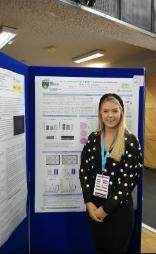
Below is a summary of each of the six finalist's presentations and Best Poster winner:
The Electrician who gets on your Nerves: Developing a new therapy for Multiple Sclerosis By Lisa McDonnell, ENGAGE 2021 Grand Final Winner (Supervisor: Prof Keith Murphy)
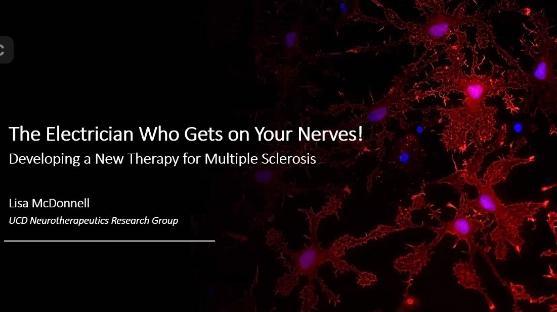
Multiple sclerosis (MS) is a disease of the nervous system that occurs when the body’s own immune cells inappropriately invade the brain and spinal cord and mistakenly attack the myelin sheath. The myelin sheath is an insulating layer surrounding nerves which is required for the rapid transmission of the electrical signals in our brain that allow us to think, move and sense the world around us. Damage to the myelin sheath permanently disrupts the nerve’s ability to send electrical signals which prevents the brain from effectively communicating with the rest of the body. As a result, patients suffer issues with their cognition, mobility, and senses.
Currently, there is no cure for MS. Therefore, there is a vital need to develop therapies that can help repair the damaged myelin sheath in order to restore normal electrical signalling in the brain. We have identified a compound called Nefiracetam as a possible new treatment for MS. In experimental models of MS, Nefiracetam was found to repair damaged myelin sheaths. Our aim is to understand how this drug encourages repair by investigating how it affects the cells that are involved in the repair of the myelin sheath.
“You gotta be kidney me?” – growing kidney tissue in a dish! by Shane Clerkin, ENGAGE 2021 Runner Up (Supervisor: Assoc Prof John Crean) (opens in a new window)Video link to live presentation here
Kidney diseases are now recognised as a top ten leading cause of death globally. It is estimated that a staggering one in twelve people in Ireland suffer from Chronic Kidney Disease (CKD), largely due to the surging incidence of Diabetes Mellitus. Individuals with CKD gradually lose the ability to appropriately filter excess fluids and wastes in their blood. Progression to later stages of the disease may ultimately require artificial filtering of blood (dialysis) and organ transplantation, which are costly and extremely limited by the number of available donors.
Over the last number of years, scientists have focused on generating human organs from scratch in the laboratory. These “organoids” are grown from stem cells, which are immature cells that can grow into miniaturised versions of human organs once provided with the correct growth conditions. My research focuses on creating optimal environments to grow kidney organoids by closely mimicking how this organ normally develops in the body. To date, I have been able to generate kidney tissue from stem cells within three-dimensional water-swollen gels, known as “hydrogels”. Due to their high-water content and mechanical similarity to natural tissues, these hydrogels represent an exciting means to grow kidney tissue in the laboratory. This is not science fiction! – The goal is to use organoids to improve our understanding of how our kidneys develop, to more accurately model renal diseases and ultimately generate replacement tissues for some of the most poorly treated diseases globally.
Switching to Green: How plants can treat inflammation in the brain by Aoife Cosgrave (Supervisor: Dr. Derek Costello) (opens in a new window)Video link to live presentation here
For years scientists have investigated how the immune system works to help the body fight infections, yet up until recently little was known about what happens in the brain. However, research has now shown that not only is the brain made up of billions of brain cells called neurons but that there are also immune cells in the brain called microglia. Microglial cells work to keep the brain healthy, and they are very good at noticing when changes happen. When brain tissue is damaged or toxic substances are found, the microglia respond by releasing inflammatory chemicals and clearing up debris. However, if this inflammation becomes uncontrolled it can cause neurons to die. This “neuroinflammation” has been identified as a key hallmark of many brain diseases. Therefore, if the brain’s environment is restored to normal levels it may help with the treatment of these disorders. Research has shown that therapies which fight inflammation may stop microglia switching on and reduce the damage to neurons. Promising work on compounds from the Cannabis plant show the potential to do this. In the lab I am working with some of these plant compounds (phytocannabinoids) see how they reduce inflammation in microglia and neurons and therefore in the future may be used in the treatment of neuroinflammation.
COVID-19 - a silent killer beyond the lungs by Luisa Weiss (Supervisor: Prof Patricia Maguire) (opens in a new window)Video link to live presentation here
What would your answer be if you were asked what COVID-19 is? Most people would answer it is a lung disease because patients who have COVID-19 show difficulties breathing, coughs and might even need breathing support. But doctors all over the world found that patients with COVID-19 not only have lung symptoms but also a massively increased risk of clotting, a blockage of blood flow in the body. My research looks at why so many clots form in COVID-19 and how this can be prevented. Clots forming is a natural mechanism of the body to heal an injured vessel for example after a cut. It involves the activation of platelets, the smallest blood cells. Once activated, they stick to the injured vessel and close it. However, in many diseases such as stroke and heart attack, platelets are hyperactive and form bigger clots than necessary, that leads to the blockage of blood flow. And this also happens in COVID-19. By comparing the platelets from patients with COVID-19 to patients without COVID-19, I will find out what COVID-19 is doing to the platelets to make them form the massive clots. This will help doctors understand the disease better and help them give the right treatments to save the lives of their patients.
The land that shapes our water - Faecal pollution and increasing levels of Antimicrobial Resistance in our waters by Tristan Nolan (Supervisor: Prof Wim Meijer) (opens in a new window)Video link to live presentation here
The World Health Organisation recognises antimicrobial resistance as one of the biggest threats to global human health. Antimicrobials are the backbone of modern medicine. However, an increasing prevalence of resistance is threatening to undermine this essential resource. The role of the environment as both a reservoir, and as an avenue for the spread of resistance highlights its importance as an area of research. Water is the medium which connects humans and animals. Water quality is a global issue, with faecal pollution one of main culprits of poor quality. Faeces has shown to potentially harbour dangerous microbes and active antimicrobials, which can lead to illness and microbes that are difficult to treat.
Rivers can flow through multiple land uses, such as agriculture and urban areas. Upstream pollution of rivers can impact downstream waters, controlling quality and posing a health risk. Thus, we aimed to assess water quality from three rivers impacted by different land uses, all discharging into Dublin Bay. A Bay which has three designated bathing waters. Water samples were taken every two weeks from fourteen locations on the rivers Liffey, Tolka and the Dodder. Faecal indicator bacteria (FIB) were enumerated, along with levels of microbial source tracking markers (human & ruminant) and antimicrobial resistance genes. Results show that FIB increase as they move from their sources. The river Liffey and Dodder showed greater changes in FIB, with over four and three orders of magnitude differences for both FIB in both rivers. FIB in the river Tolka ranged over two orders of magnitude from source to discharge. The highest levels of faecal pollution were seen in urban areas, just before reaching Dublin Bay. Results also highlight the impact of land use, using just four antimicrobial resistance genes, that a clustering structure closely related to land use starts to emerge. These results highlight a real problem with water quality and the influence of land use. The levels of faecal and antimicrobial pollution seen presents an immediate health risk to the public and demonstrate the need for an update to the routine monitoring management of surface waters.
Pollinators and Pesticides - What's the Buzz by Alison O'Reilly (Supervisor: Dr Dara Stanley) (opens in a new window)Video link to live presentation here
Bees and other pollinators provide essential and economically important services for global crop pollination. When pollinators visit and hop between the flowers of these crops for nectar and pollen, they accidentally move pollen from plant to plant, assisting with plant reproduction. Many of the world’s crops either require or benefit from this service provided by insects to ensure they produce high yields of fruits or seeds. We as humans benefit from this service too! If it were not for pollinators, we would struggle to maintain a healthy balanced diet! Pollinator populations have been in decline for a number of years and one of the potential causes of this is the use of pesticides. When these chemicals are sprayed or applied as a coating on seeds, they can contaminate the nectar and pollen of the plants. When pollinators are foraging on these plants, they come into contact with the chemicals physically and orally. Previous studies have found that exposure to pesticides can affect the health and behaviour of pollinators, and even their ability to pollinate important crops. The aim of my research is to investigate this further by observing bees that have been exposed to various pesticides and evaluate whether crop yield is affected after being pollinated by these bees.
Kayleigh Slater won Best Poster Presentation for her research 'Investigating new treatments for Uveal Melanoma', (Supervisor : Prof Breandán Kennedy)
